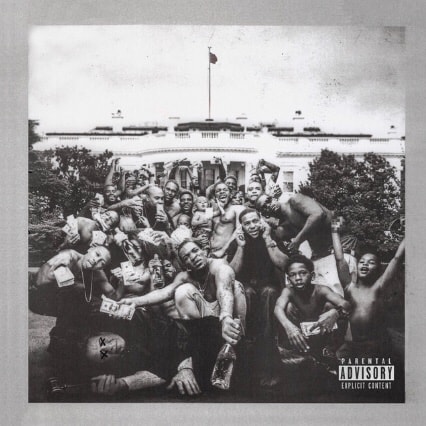Culture Pick | Ranking Kendrick Lamar’s albums

November 7, 2021
Ever since the release of Kendrick Lamar’s fourth studio album “Damn.” in 2017, fans have eagerly anticipated the return of the critically acclaimed rapper.
Thankfully, those who have waited finally have reason to be excited; in August, the rapper’s cryptic website let fans know in a message that his last album for Top Dawg Entertainment was almost finished.
Kendrick also claimed a spot in the next Super Bowl Halftime Show and delivered a few verses on Baby Keem’s “Melodic Blue.” In the meantime, fans have been left to endlessly reinterpret and relisten to Lamar’s previous work.
In anticipation of Lamar’s final TDE album and in celebration of an incredible artist, here’s a ranking of his studio albums.
5: “Untitled Unmastered” (2016)
In a lot of ways, it probably isn’t fair to compare this album to the others on this list. After all, “Untitled Unmastered” is composed of leftover songs from the sessions that yielded “To Pimp a Butterfly.”
Sonically, the tracks here contain the same experimental sounds as “To Pimp a Butterfly,” and there are impressive standouts like the undeniably catchy “Untitled 07.” However, the whole project often feels disjointed. Unfortunately, the tracks here, while dynamic, just don’t coalesce into something as impressive as an official finished album.
4: “Section .80” (2011)
Lamar’s first full-length album set the tone for the rest of his career, delivering clever rhymes, impressive storytelling and social messages that demonstrated potential beyond that of his peers.
Songs such as “Ronald Reagan Era” and “Poe Man’s Dreams” discuss social themes, while “Hol’ Up” flexes Kendrick’s technical ability with fun, absurd lines. While the sound here is less polished and there are some low points, all of the essential elements are here: impressive storytelling, clever lyricism and mature perspective.
It all comes together to highlight the aggressive voice of a young, talented performer.
3: “Damn.” (2017)
If “Section .80” is Lamar at his least polished, “Damn.” is him at his commercial peak. This album, which contains monster singles “DNA.” and “Humble.,” introduces us to the new character Kung Fu Kenny. Framed as a conflict between “wickedness or weakness,” the album presents Kung Fu Kenny, and America, with a series of moral choices between aggression and love.
Ultimately this culminates in the song “Duckworth.,” which contains an incredible reveal that the founder of Kendrick’s label once tried to rob his father at gunpoint when they were much younger.
Had his father chosen wickedness that day, Kendrick might have been raised by a single mother. Most artists wouldn’t wait until their fourth album to tell this story. Of course, most artists also wouldn’t turn it into a lesson warning America not to forget Hebrew morality.
2: “Good Kid, M.A.A.D. City” (2012)
The cover reads “A short film by Kendrick Lamar,” and there’s probably no better way to describe it. The story of his Compton, California, upbringing, this project catapulted Kendrick into the national spotlight.
Sophomore albums are often weaker as artists try to replicate the success of their debut, but “Good Kid, M.A.A.D. City” completely upends this trend by upping the ante in production and storytelling.
The album’s narrative gives us a tour of Kendrick’s youth, from gang violence, “M.A.A.D. City,” to an attempted robbery with his friends, “The Art of Peer Pressure,” to alcoholism,“Swimming Pools (Drank),” and finally, to his religious conversion and emergence as a popular artist.
The undisputed masterpiece here is “Sing About Me, I’m Dying of Thirst,” in which several stories are woven together into a 12-minute track about violence, death and economic struggle.
1: “To Pimp a Butterfly” (2015)
A go-to example of a modern classic, this album is the creative left turn that elevated Kendrick’s artistry and surprised fans everywhere. Retreating into the studio with musical powerhouses such as George Clinton, Thundercat and Terrace Martin, Lamar honed a jazz-inspired sound to send a powerful message about the history of Black music in the U.S.
Although “To Pimp A Butterfly” has a lot of personal moments, this time the story seeks to highlight a wider historical problem: In the U.S., Black artists have often been used for profit instead of having their voices elevated for wider advocacy. Listening to the album, we hear Lamar question, and then challenge, his place in such an exploitative music industry.
One of the biggest turning points in the album is a trip to Africa in “Momma” that imbues Lamar with a series of lessons for the U.S. The storytelling on “How Much a Dollar Cost?” is complete and beautiful, finishing with the startling realization that a man who has been begging for change from the narrator is actually God.
However, the most shocking reveal in the album actually comes from the last song, “Mortal Man,” in which Lamar stages a conversation with Tupac using clips from an old interview. The album made a huge splash when it came out in 2015, and anthems such as “Alright” still soundtrack protests across the country.
Regardless of how you’d rank the above albums, it’s hard to deny the impact they’ve had on the music industry over the past decade.
Of course, given the number of creative departures Kendrick’s career has taken, fans have no idea what to expect from his upcoming project. Whether we see a continuation of the trap sounds on “Damn.” or a full sonic reinvention, I wouldn’t expect anything less revolutionary or powerful than the albums listed.
Questions? Email the Culture desk at [email protected].










